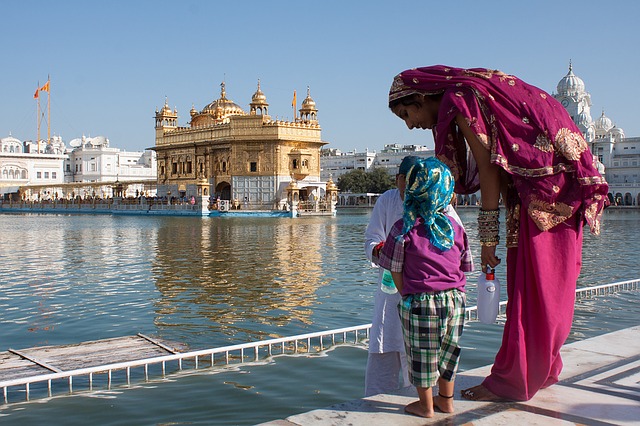A Visit to the Harmandir Sahib, Amritsar’s Golden Temple

I felt almost fraudulent as I visited the Harmandir Sahib for the first time. The vast majority around me were religious pilgrims undertaking a spiritual journey, while I was only beginning to understand everything happening around me.
The Harmandir Sahib, in the Indian Punjabi city of Amritsar, is known as the Golden Temple in English. It is home to the eternal guru of the Sikh faith, the Guru Granth Sahib, a sacred religious text, and it is the most holy place in the Sikh faith. It attracts hundreds of thousands of worshipers per year. But I simply looked around in a state of confusion, trying to make sense of it all. Seas of families, individuals, and children come to pray, dip in the holy waters around the temple, or rest in the shade away from the brutal midday sun. A thousand different images, colours, and sounds ran through my mind.
Amritsar, which translates as the pool of nectar, takes its name from the Amrit Sarovar, the holy waters of the temple. Amritsar is acity of just over one million in the north-western part of India, in the state of Punjab. The biggest drawcard to Amritsar is, of course, the Harmandir Sahib, built in 1577 by Guru Ram Das. In 1830, Sikh leader and warrior Ranjit Singh donated gold to encase the shrine with pure gold, leading to the English term, the Golden Temple.
Dining on the floor in open, communal rooms, it was impossible not to feel connected to everyone around me, as everyone has been brought together by the aura of the temple.
As a gurdwara, or holy Sikh temple, modest dress is required, both men and women must cover their heads, and shoes must be left at the cloakroom before entering. As I walked through the gates and saw the Harmandir Sahib in for the first time, I was immediately aware of it through all of my senses: the women in their vibrant and colourful salwar kameez, the blinding glow of the sunlight bouncing off the golden roof, the feel of the smooth white marble under my bare feet, and the enticing smells coming from the langar.
Once inside, the gurdwara complex is vast, and there is so much to be noticed. I was struck by the amazing inclusivity and openness of the Sikh faith, and how that acceptance is visibly demonstrated throughout the temple. This is first seen in the entrance- a walk around the perimeter shows the four entrance gates, demonstrating that everyone from all directions is welcome to enter.
The inclusive nature of the gurudwara was most clear to me through the community kitchen, or langar. Langar is a concept in the Sikh faith in which a vegetarian meal is served to anyone who wants it, at no cost, regardless of religion, background, or status. The langar at the Harmandir Sahib feeds 50,000-100,000 people per day! It’s actually the largest community kitchen in the world. It operates like a well-oiled machine, despite being staffed predominantly by volunteers. They give their time–be it a few hours, days, or months–to serve their faith via service in the langar.
I was immediately aware of the Harmandir Sahib through all of my senses: the women in their vibrant and colourful salwar kameez, the blinding glow of the sunlight bouncing off the golden roof, the feel of the smooth white marble under my bare feet, and the enticing smells coming from the langar.
As we entered the langar we were given plates, a cup, and cutlery, and then took our place on the floor mats, along with hundreds of others. Volunteers walk up and down the hall, serving rice, daal, roti, and vegetarian fare, all wholesome and delicious. Dining on the floor in open, communal rooms, it was impossible not to feel connected to everyone around me, as everyone has been brought together by the aura of the temple.
As a visitor from a western background, the concept of the langar at first felt strange to me, as I felt uncomfortable accepting food for free when I am capable of looking after myself. However, the more I learned about the concept of langar, the more I came to understand the beauty of it. Langar brings together men, women, and children, regardless of caste or background. It is a place where differences are put aside and everyone is respected as equals. This is something everyone can learn from, and it’s a beautiful way of promoting tolerance, acceptance, and equality.
A Visit to the Harmandir Sahib, Amritsar’s Golden Temple.
If you are visiting the gurdwara, I highly recommend starting with a visit to the Interpretation Center, which provides a series of introductory videos (via an audio headset) on the history of the temple and information on Sikh history. Visit the temple afterwards, and you’ll have a much better understanding of its importance and meaning.
I’d also encourage a visit both in both the daytime and in the night, as the temple looks and feels completely different when it’s lit up at night. Although the temple is very busy any time of the day or night, find a peaceful spot to reflect and truly let the energy and beauty of the place, and its purpose, find you.
Photo for A Visit to the Harmandir Sahib, Amritsar’s Golden Temple by Pixabay.









What an experience! I have heard about this place, but not from this perspective. Great read.